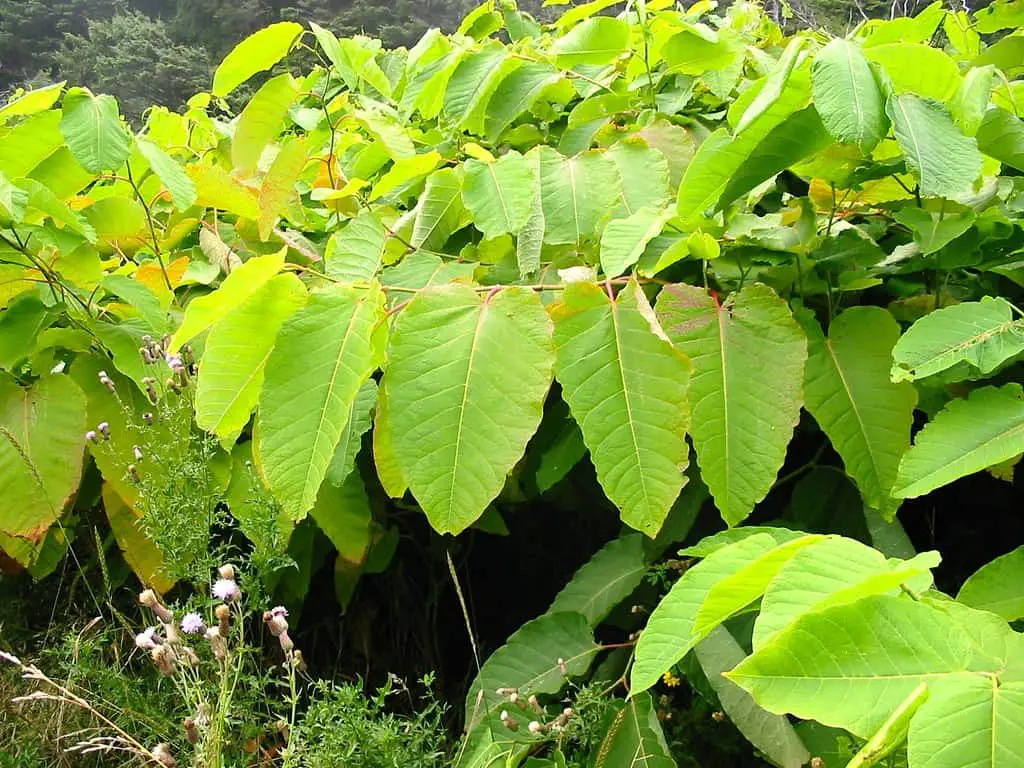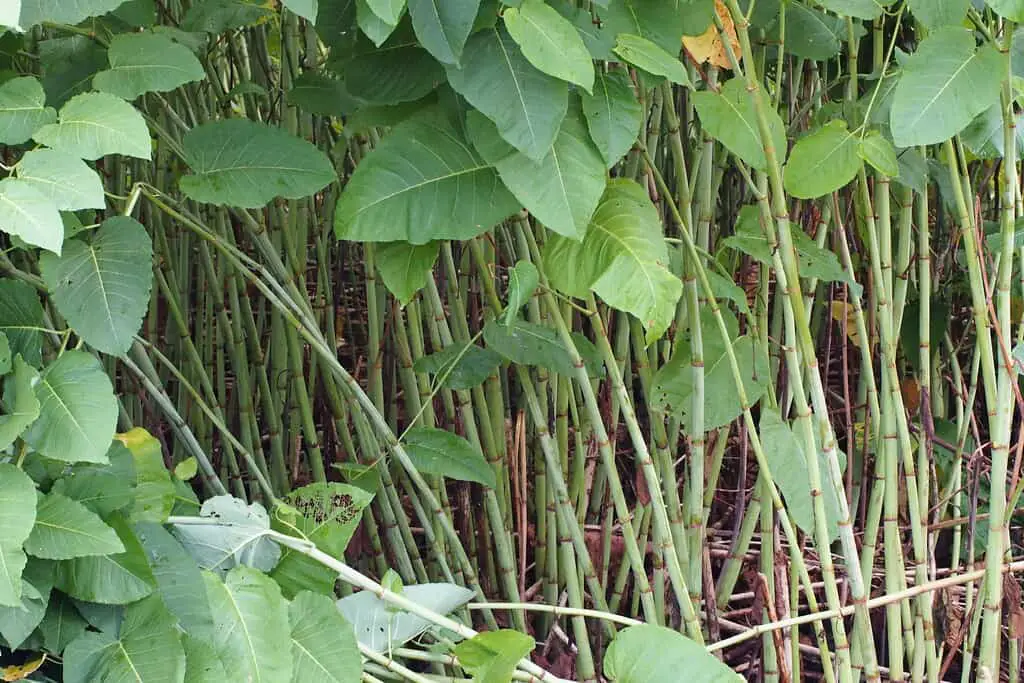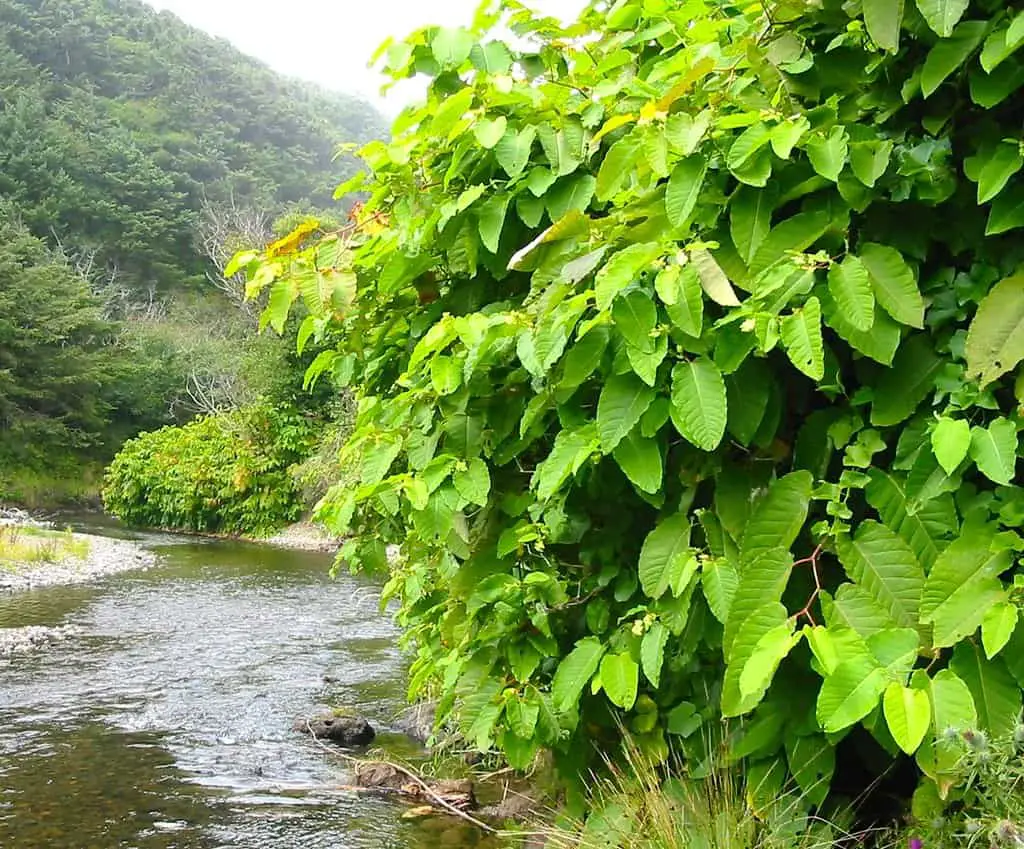Giant Knotweed is similar to Japanese knotweed but only larger with its elongated leaves.
Giant knotweed looks like Japanese knotweed because it is simply a larger variant of the plant. Giant specimens can grow up to 4 metres tall and can be distinguished by the green hue to the usually creamy white flowers.
Unfortunately, Giant knotweed shares many of the same undesirable features with its close relative, to the point where it can almost be considered to be the same plant.
This blog post will provide an in-depth guide on what Giant Knotweed are, how they grow, and how to eradicate them from your garden.
Quick Facts
| Common names: Japanese bamboo, Sakhalin knotweed Scientific name: Fallopia sachalinensis Family: Polygonaceae Origin: non-native Flowering season: July to September Habitat: riverbanks, stream banks, roadsides and moist, disturbed ground |
Giant Knotweed Identification
This weed is the largest of three closely related invasive knotweeds that are found in the UK and are listed as noxious weeds.
The biggest distinction between Giant knotweed and Japanese knotweed is the plant’s sheer size; however, there are a few minor distinctions. Giant knotweed blossoms have a green tint to them, unlike Japanese knotweed flowers, which are pure white.
Giant knotweed also has larger, more rounded leaves on the underside with irregularly dispersed hairs.
What does Giant Knotweed look like?
Characteristics that make up the Giant Knotweed leaf, stem, root and flower are detailed below.
If pieces of the plant float downstream it will often grow where it takes settles. Like Japanese knotweed, this weed will take over an area forcing native plants to decline and eventually fail.

Leaves: The leaves are 6 to 16″ (15 cm to 40 cm) long and 4 to 8” (10 cm to 28 cm) wide.
Leaves are a deep or bright green colour with a dull matt appearance. With a deeply heart-shaped base and a blunt leaf tip.
Diagnostic hairs on the leaf underside are long, thin and wavy (hairs are sparse and sometimes fall off late in the season, best seen with a hand lens June through mid-September).

Stems: Giant knotweed is the biggest of the three invasive knotweeds, with stems usually between 6 and 16 feet, but reaching as much as 17 feet tall in some areas. The stems are smooth, hollow and light green, resembling the canes of bamboo, and sparingly branched.
The more established the weed, the woodier the stems become and they increase in mass as the plant ages. They also have some red banding.
Roots: Giant knotweed roots can extend to depths of 2m. This means Giant knotweed is capable of causing similar damage to properties. The roots are orange in colour.
The rhizomes develop pink coloured modules in early spring. From these modules, shoots begin to sprout as early as April. However, Giant knotweed stems from previous years may still be present and can generate new shoots for up to another 12 months.
They continue to generate horizontal spreading and creeping rhizomes that can spread under the surface of the ground. 3 metres deep and up to 7 metres from the surface crown.
Flowers: The flowers are small, creamy white to greenish-white, and grow in short, branched clusters from leaf axils near the ends of the stems.
Flower clusters are generally shorter than the subtending leaf, unlike the longer flower clusters found on itadori (Japanese) knotweed and the mid-size clusters found on hybrid knotweed.
Flowers are small and come in dense panicles up to 10 cm long in late summer or early autumn.
Fruits: these are three-sided, black and shiny.
Giant Knotweed Seasonal Changes
The plant produces bright white flowers in long terminal clusters from July through September, followed by blackberries that ripen in August and persist into late autumn.
Giant Knotweed in Spring
In the Spring, reddish shoots emerge and begin to grow rapidly, reaching heights of around 4 m by the Summer, when flowers will appear in amongst the dense foliage.
At the same time, the roots of this weed extend deep into the ground, about 2 meters vertically and range horizontally up to 15 or 20 meters.

Giant Knotweed in Summer
In the summer months, giant knotweed is a towering plant. Its growth has been stunted by human interference and it will never reach its full height of 13 feet tall.
This plant is hardy, but not in the way you might think. It flourishes well during the summer months and even soaks up water like a sponge to protect itself from drought conditions that may come at any time of year.
Giant Knotweed in Autumn
In the autumn, the foliage begins to wilt as the leaves turn yellow and then eventually an orange and red mix and the plant’s energy reserves are transferred to the rhizomes for winter (These rhizomes wait until early next spring to sprout).
Giant Knotweed in Winter
By Winter the plant above the ground will be reduced to pale hollow stalks that can take 12 months or more to decompose.

How to get rid of Giant Knotweed
Once Giant knotweed invades an area, in even the most minute manner, it is stubborn and will take root.
The good news is that Giant knotweed is treatable in the same manner as Japanese knotweed is. Giant knotweed can be treated, removed, and controlled using herbicides, excavation, and root barriers.
Method One – Herbicide Treatment
The best weed killer to rid you of this weed has to be a herbicide that contains glyphosate or triclopyr ester as the active ingredient.
As with all glyphosate or triclopyr-based weed killers you need to be careful around other plants as it will kill indiscriminately.
Mix this with water according to instructions on package directions then apply evenly over your target area when temperatures are between 60-85 degrees Fahrenheit.
You will see results within 2 weeks providing there is no rain or irrigation during the application time frame.
Depending on the extent of the infestation, it may take several seasons for all plants to be killed by some of these treatments unless they are applied annually.
Several treatments might be required to completely eradicate it from your property.
Method Two – Digging it out
To remove giant knotweed by digging or pulling is not recommended. These methods are unsustainable and can lead to the spread of rhizome fragments via carting activities or wild animals due to discarded waste piles.
If you resolve to this method and you identify where the root system of giant knotweed is located, use a shovel to cut down any vines that are growing above ground before digging out all of the root structure with an excavator.
Once removed, make sure not to leave anything behind as this could lead to regrowth from dormant seeds or even new plants propagating from pieces left on-site by mistake.
Giant Knotweed Management
Giant knotweed management involves multiple treatments. However, effective control can be obtained with a combination of herbicides, cultural practices and prescribed burning and torching.
In Conclusion
Giant Knotweed, a non-native invasive plant, can grow up to 8 feet tall in as little as three months after sprouting. So it comes as no surprise that you need to act fast to control and manage this weed.
It’s easy enough for homeowners with some determination on their own property but not quite so simple when you’re dealing with this weed at its full height of growth.
Don’t be afraid to seek professional help if you have an overwhelming area that is infested with this weed. Sometimes it’s easier to use an expert to get the result you want and more importantly, protect your valuable property.


